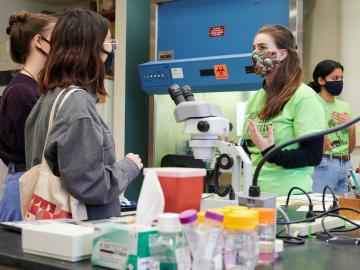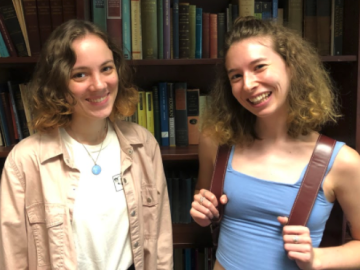Campus News
Senior Symposium 2016 Preview, Part 1
April 22, 2016
Lisa Gulasy
The Office of the Dean of Arts and Sciences and the Office of the Dean of Studies invite all members of the campus and community to celebrate the academic and artistic endeavors of members of the Class of 2016 at the seventh annual Senior Symposium on Friday, April 29, 2016.
The symposium begins at 1 p.m. in King 306 with opening remarks from Tim Elgren, dean of the College of Arts and Sciences. Concurrent panels begin at 1:30, 2:45, and 4 p.m. in various rooms on the third floor of King, and a reception in the Rice/King Courtyard will begin at 5:15 p.m.
This year, more than 50 seniors and fifth-years on 17 panels will each give a 12-minute presentation regarding work they performed for honors or capstones or research they conducted individually or with a faculty mentor.
To get a sense of the rich variety of topics covered at this year’s symposium, the Source is sharing a handful of project abstracts written by presenting seniors in the days leading up to the event. Learn more about the students included in today’s batch by clicking individual photos in the gallery above.
Katherine Moncure, “Inverted Quarantine: Individual Response to Collective Fear”
In Shopping Our Way to Safety (2007), sociologist Andrew Szasz coined the term “inverted quarantine” to describe how Americans react to the changing natural environment. Inverted quarantine, or the impulse to remove oneself from perceived environmental dangers, often manifests in consumption behavior such as consuming only organic food, drinking filtered or bottled water, moving from a city to a suburb, or even being enclosed in a gated community. Although inverted quarantine may result in some form of protection, in the long run it is unsustainable in the face of the changing natural environment. Through investigations in literature and in-depth interviews with Ohio farmers, Oberlin College students, and parents in Fairfield County, Connecticut, this study examines different ways that environmental dangers are perceived and addressed across three different demographics.
Madeleine Aquilina, “Boston’s Villa Victoria: A Space Produced”
Aquilina’s research situates the activism and architectural structures of Villa Victoria, a community-designed public housing project in Boston’s South End, into broader 20th-century discourses of urbanism. In 1968, the city of Boston sought to displace Puerto Rican residents in order to redevelop the neighborhood and was met with organized resistance, which eventually resulted in resident control and design of the housing project. Aquilina uses archival materials and visual analysis to identify a slippage between the aims of the activists and the resulting architectural image. Relying on the theoretical apparatus from French neo-Marxist sociologist Henri Lefebvre, her research seeks to reconcile the radical activism and architectural schemes by broadening definitions of space beyond the physical.
Timothy Chung, “Clades Variana: The Literary Shadows of Teutoburg in Tacitus’ Annals
Tacitus’ treatment of the Battle of Teutoburg Forest in Annals 1.61-62 is a graphic and gruesome account of one of Rome’s greatest military defeats. As the language seems to be particularly evocative of the literary traditions of epic poetry and ancient tragedy, Chung argues that Tacitus invites an interpretation of his historical narrative under a literary lens, particularly as it applies to the figure Germanicus Caesar. Such an approach enriches our reading of Annals and provides insight into Tacitus’ intent to disparage the rule of the Julio-Claudians.
Alexandra Kahn, “Entomopathic Nematodes Found in a Population of Emerald Ash Borers from Connecticut”
The Emerald Ash Borer (Agrilus planipennis) is an invasive beetle in the U.S. that has been spreading since 2003, with devastating effects on ash trees. One potential method for controlling outbreaks is biological control. Kahn looked for nematode parasites within a population of EABs with the goal of finding species that had potential to be used as bio- control agents and found at least two, both at low infestation rates. One of these species, due to its close phylogenetic relatives, seems unlikely to be useful for large-scale bio-control, but the other is still worth further investigation.
Cole Lumpkin, “Soundscaping: The Art and Theory of Audio Engineering”
With the high rate of advancement in sound reproduction over the course of 100 years, the concept of recording and enhancing sound for playback has become an integral part of not only the music industry but the music itself. The role of the recording and mixing engineers is to forge “soundscapes” using a set of parameters that modify and organize the recorded sound. These techniques are integral to discussing any music theory today, as music has transcended being solely performance-practice based, and the technique of mass reproducing a song is now defined by the sculpting of it sonically.
Emma Sterling, “Don’t Look Back: A Retrospective on Orpheus and Eurydice in Augustan Poetry”
In this study of three Augustan poets (Vergil, Horace, and Ovid) and their use of the Orpheus and Eurydice myth, Sterling delved into what each poet takes from the myth and how they transform and alter it to suit their own needs. Each of the three writes in a different genre of poetry, and each derives meaning from the base myth. Each subsequent poet takes from the predecessor’s work, alluding to and in some cases criticizing the others’ methods. This myth remains popular even today, obtaining its most well-known form from these three poets.
Nathaniel Wehr, “Habitat Selection and Activity Patterns Among Wading Birds”
Human destruction of wetlands in the last two centuries has resulted in the destruction of wading bird habitats. Such habitats are crucial because wading birds are important top predators. Wehr and collaborators studied wading bird habitat selection patterns at Old Woman Creek National Estuarine Research Reserve. They observed wading birds via cameras and active transects in the estuary. They concluded that wading birds do not use tall, dense emergent vegetation; submerged aquatic vegetation does not play a role in habitat selection; and snags are an underrepresented facet in wading bird habitats.
Tags:
You may also like…
Students Explore Oberlin’s Range of Research in This Year’s Lab Crawl
November 17, 2021
Lab Crawl was well attended this semester with many students making stops at demonstrations held in one or more of 22 labs across campus.
This Week in Photos: Alzheimer's Research
August 5, 2021
A picture of a student transferring an opaque substance into a gel box in a neuroscience lab serves as inspiration for this week’s photo series.
Emma Glen and Emily Hudson Publish Translations and Book Review
August 4, 2021
Third-years demonstrate artistry and command of language with translations of Latin poet Catullus.


